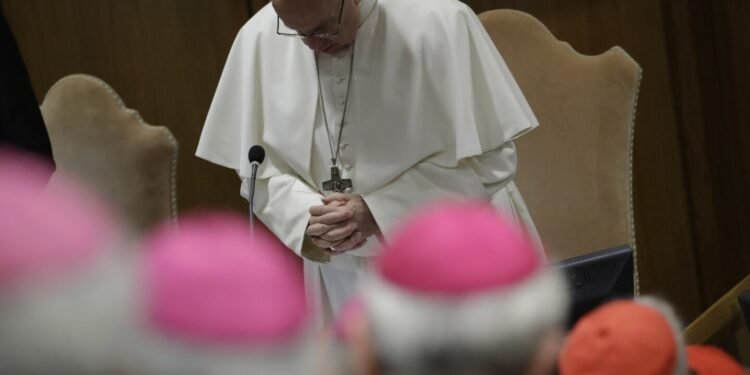VATICAN CITY (news agencies) — One afternoon in mid-December, Pope Francis had a meeting that wasn’t on his official agenda or otherwise recorded, that underscored the utter dysfunction of the Catholic Church’s response to the global clergy sex abuse scandal.
In the main reception room of the Vatican hotel where he lives, Francis met for more than an hour with a Spaniard who as a young seminarian was molested by his spiritual director. The former seminarian was desperate.
He had lodged a complaint with the Toledo, Spain Archdiocese in 2009, and visited Vatican offices multiple times to deposit damning documents and demand action be taken against his abuser and the bishops who allegedly covered for him. But for 15 years, he had received no justice from the church.
While Francis’ decision to hear his story was laudable and pastorally sensitive, it was also evidence that the church’s in-house system to deal with abuse isn’t working — from the laws available to punish abusers to its policies for helping survivors. For every victim who has enough well-connected friends at the Vatican who can arrange a papal audience, countless others will never feel that the church cares for them or will provide them justice.
Five years ago this week, Francis convened an unprecedented summit of bishops from around the world to impress on them that clergy abuse was a global problem and they needed to address it. Over four days, these bishops heard harrowing tales of trauma from victims, learned how to investigate and sanction pedophile priests, and were warned that they too would face punishment if they continued to cover for abusers.
Yet five years later, despite new church laws to hold bishops accountable and promises to do better, the Catholic Church’s in-house legal system and pastoral response to victims has proven still incapable of dealing with the problem.
In fact, victims, outside investigators and even in-house canon lawyers increasingly say the church’s response, crafted and amended over two decades of unrelenting scandal, is damaging to the very people already harmed — the victims. They are often retraumatized when they summon the courage to report abuse in the face of the church’s silence, stonewalling and inaction.
“It’s a horrific experience. And it’s not something that I would advise anyone to do unless they are prepared to have not just their world, but their sense of being turned upside down,” said Brian Devlin, a former Scottish priest whose internal, and then public accusations of sexual misconduct against the late Scottish Cardinal Keith O’Brien marked O’Brien’s downfall.
“You become the troublemaker. You become the whistleblower. And I can well understand that people who go through that process end up with bigger problems than they had before they started it. It’s a hugely, hugely, destructive process.”
Then-Cardinal Joseph Ratzinger revolutionized the way the Catholic Church dealt with abusive clergy in 2001, when he persuaded St. John Paul II to order all abuse cases be sent to his office for review.
Ratzinger acted because, after nearly a quarter century at the Congregation for the Doctrine of the Faith, he had seen that bishops weren’t following the church’s own laws and were moving predators around from parish to parish rather than sanctioning them.
At the end of his 2019 summit, Francis vowed to confront abusive clergy with “the wrath of God.” Within months, he passed a new law requiring all abuse to be reported in-house to church authorities (but not to police) and mapped out procedures to investigate bishops who abused or protected predator priests.
But five years later, the Vatican has offered no transparency or statistics on the number of bishops investigated or sanctioned. Even the pope’s own child protection advisory commission says structural problems built into the system are harming victims and preventing basic justice.
“Recent publicly reported cases point to tragically harmful deficiencies in the norms intended to punish abusers and hold accountable those whose duty is to address wrongdoing,” the Pontifical Commission for the Protection of Minors said after its last assembly. “We are long overdue in fixing the flaws in procedures that leave victims wounded and in the dark both during and after cases have been decided.”
At the 2019 summit, the norms enacted by the U.S. Catholic Church for sanctioning priests and protecting minors were touted as the gold standard. The U.S. bishops adopted a get-tough policy after the U.S. abuse scandal exploded with the 2002 Boston Globe “Spotlight” series.
But even in the U.S., victims and canon lawyers say the system isn’t working, and that’s not even taking into consideration the new frontier of abuse cases involving adult victims. Some call it “charter fatigue,” that the hierarchy simply wants to move on beyond the scandal that spawned the 2002 Charter for the Protection of Children and Young People.
The Rev. Thomas Doyle, a U.S. canon lawyer who worked for the Vatican embassy in Washington and now provides consulting for victims, says he no longer advises they pursue church justice.
Why? Because “the church will screw them every which way from Sunday,” he said.
“Don’t waste your time,” Doyle says he tells victims. “The only justice, or semblance of justice that has been meted out is in civilian courts because the church can’t screw them up.”
Nearly every investigation into abuse in the Catholic Church that has been published in recent years has identified the church’s in-house legal system as a big part of the problem, from church-commissioned reports in France and Germany to government inquests in Australia, parliamentary-mandated studies in Spain and law enforcement investigations in the U.S.



 Pakistan Rupee Exchange Rate
Pakistan Rupee Exchange Rate





